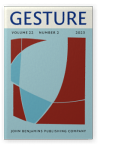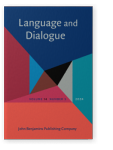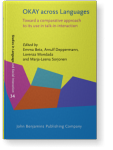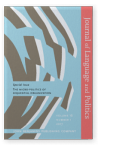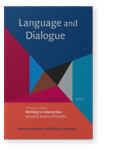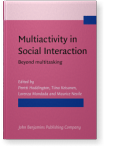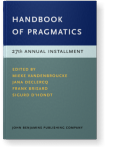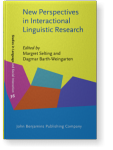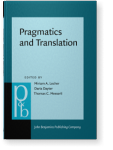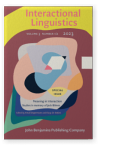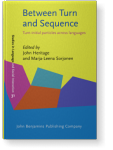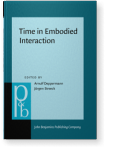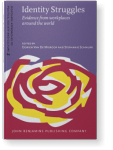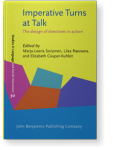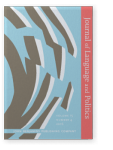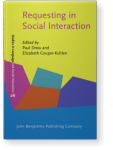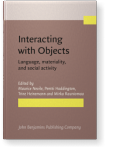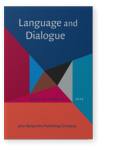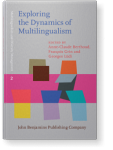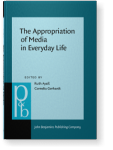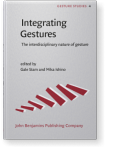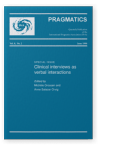Lorenza Mondada
List of John Benjamins publications for which Lorenza Mondada plays a role.
Journals
OKAY across Languages: Toward a comparative approach to its use in talk-in-interaction
Edited by Emma Betz, Arnulf Deppermann, Lorenza Mondada and Marja-Leena Sorjonen
[Studies in Language and Social Interaction, 34] 2021. vii, 440 pp.
Subjects Discourse studies | Pragmatics | Semantics | Syntax | Theoretical linguistics
The micro-politics of sequential organization: Contributions from conversation analysis and ethnomethodology
Edited by Lorenza Mondada and Sara Keel
Special issue of Journal of Language and Politics 16:1 (2017) v, 147 pp.
Subjects Communication Studies | Discourse studies | Pragmatics
Writing in interaction
Edited by Lorenza Mondada
Special issue of Language and Dialogue 6:1 (2016) v, 204 pp.
Subjects Anthropology | Applied linguistics | Cognition and language | Communication Studies | Computational & corpus linguistics | Dialogue studies | Discourse studies | Pragmatics | Psychology | Sociology
Multiactivity in Social Interaction: Beyond multitasking
Edited by Pentti Haddington, Tiina Keisanen, Lorenza Mondada and Maurice Nevile
[Not in series, 187] 2014. vii, 289 pp.
Subjects Cognition and language | Communication Studies | Discourse studies | Industrial & organizational studies | Interaction Studies | Pragmatics
2024 Revisiting talk in space: The inescapable mobility of social interaction Handbook of Pragmatics: 27th Annual Installment, Vandenbroucke, Mieke, Jana Declercq, Frank Brisard and Sigurd D’hondt (eds.), pp. 215–241 | Chapter
2024 Introducing the “Parallel European Corpus of Informal Interaction” (PECII): A novel resource for exploring cross-situational and cross-linguistic variability in social interaction New Perspectives in Interactional Linguistic Research, Selting, Margret and Dagmar Barth-Weingarten (eds.), pp. 132–160 | Chapter
This article introduces the Parallel European Corpus of Informal Interaction (PECII), a multi-language video-corpus of social interactions in a range of informal settings and activity-contexts. After describing the basic motivation for its compilation, the design principles that underlie its… read more
2024 Requesting in shop encounters: Multimodal gestalts and their interactional and institutional accountability New Perspectives in Interactional Linguistic Research, Selting, Margret and Dagmar Barth-Weingarten (eds.), pp. 278–309 | Chapter
The chapter offers a systematic study of requests in shop encounters. Considering their detailed formats, constituted through the specific assembling of diverse resources including speakers’ turn, gaze, gestures, and body postures that I call multimodal
Gestalts
, it identifies… read more
2023 Chapter 11. From the sensing body to language, and back: Tasting and expressing taste Pragmatics and Translation, Locher, Miriam A., Daria Dayter and Thomas C. Messerli (eds.), pp. 250–280 | Chapter
Tasting sessions are an exemplary setting to investigate how participants choose descriptors for expressing sensorial judgments, based upon their own sensorial experience, as well as on existing available terminologies in different languages. On the basis of video-recorded tasting sessions of… read more
2023 The semantics of taste in interaction: Body, materiality and sensory lexicon in tasting sessions Meaning in Interaction: Studies in memory of Jack Bilmes, Deppermann, Arnulf and Elwys De Stefani (eds.), pp. 93–131 | Article
Tasting sessions constitute a perspicuous setting that reveals how a community of practice uses and shapes specialized lexicons and semantics within a situated and embodied activity. The activity aims at associating words and sensations: Participants engage with material objects (samples to… read more
2021 Chapter 10. A resource for action transition: OKAY and its embodied and material habitat OKAY across Languages: Toward a comparative approach to its use in talk-in-interaction, Betz, Emma, Arnulf Deppermann, Lorenza Mondada and Marja-Leena Sorjonen (eds.), pp. 301–336 | Chapter
This chapter examines French oké and Italian occhei as resources with which interactants manage transitions from one course of action to another. It analyzes different kinds of institutional interactions, such as work meetings, political assemblies, and guided visits in French and Italian. In… read more
2021 Chapter 2. Data and methods used in the study of OKAY across languages OKAY across Languages: Toward a comparative approach to its use in talk-in-interaction, Betz, Emma, Arnulf Deppermann, Lorenza Mondada and Marja-Leena Sorjonen (eds.), pp. 29–51 | Chapter
In this chapter, we overview the specificity of comparisons made within the perspective of Conversation Analysis (CA), and we position them in relation to other fields. We introduce the analytical mentality, methodology, and procedures of CA, and we show how we used it for the analysis of OKAY in… read more
2021 Achieving the intersubjectivity of sensorial practices: Body, language, and the senses in tasting activities Intersubjectivity in Action: Studies in language and social interaction, Lindström, Jan K., Ritva Laury, Anssi Peräkylä and Marja-Leena Sorjonen (eds.), pp. 279–302 | Chapter
Intersubjectivity is a crucial issue not only for how participants in social interaction communicate and coordinate shared projects, but also for how they engage in sensing the material world around them while they are jointly acting in that world. This paper offers an ethnomethodological and… read more
2021 Chapter 4. OKAY in closings and transitions OKAY across Languages: Toward a comparative approach to its use in talk-in-interaction, Betz, Emma, Arnulf Deppermann, Lorenza Mondada and Marja-Leena Sorjonen (eds.), pp. 93–127 | Chapter
This chapter discusses OKAY in transitions and closings, based on findings in the data from 13 languages that are analyzed in the project on OKAY. The chapter shows that OKAY features in a variety of languages in closing environments at different levels of organization, where the particle might… read more
2018 Chapter 13. Turn-initial voilà in closings in French: Reaffirming authority and responsibility over the sequence Between Turn and Sequence: Turn-initial particles across languages, Heritage, John and Marja-Leena Sorjonen (eds.), pp. 371–412 | Chapter
French has several ways of responding positively to a previous turn, such as oui, ouais, d’accord, tout à fait, exactement, bien sûr, voilà, etc. This chapter deals with voilà, offering a general overview of its uses in interaction before focusing on voilà in turn-initial position in closing… read more
2018 Chapter 5. Questions on the move: The ecology of question-answer sequences in mobility settings Time in Embodied Interaction: Synchronicity and sequentiality of multimodal resources, Deppermann, Arnulf and Jürgen Streeck (eds.), pp. 161–202 | Chapter
The paper contributes to the study of complex multimodal Gestalts involving mobile bodies in interaction and to an approach of action formation considering embodiment and the local ecology of the activity. The analyses deal with question-answer sequences in guided visits and provide for a… read more
2017 Chapter 6. Who’s the expert? Negotiating competence and authority in guided tours Identity Struggles: Evidence from workplaces around the world, Van De Mieroop, Dorien and Stephanie Schnurr (eds.), pp. 95–124 | Chapter
Guided tours are a “perspicuous setting” (Garfinkel & Wieder 1992) both for the study of asymmetries in professional contexts of interaction as well as for the analysis of how participants negotiate identities, categories and expertise. At first glance, the categorial distinction… read more
2017 The micro-politics of sequential organization: Contributions from conversation analysis and ethnomethodology The micro-politics of sequential organization: Contributions from conversation analysis and ethnomethodology, Mondada, Lorenza and Sara Keel (eds.), pp. 1–18 | Article
Conversation analysis (CA) and ethnomethodology (EM) have long dealt with political talk, but this is the first thematic volume showing the continuity and diversity of EMCA studies in this field. This introduction provides an overview of early to recent EMCA contributions to the study of… read more
2017 Chapter 3. Precision timing and timed embeddedness of imperatives in embodied courses of action: Examples from French Imperative Turns at Talk: The design of directives in action, Sorjonen, Marja-Leena, Liisa Raevaara and Elizabeth Couper-Kuhlen (eds.), pp. 65–101 | Chapter
Drawing on video recorded data in French, this chapter studies the use of imperatives in situations in which participants involved together in an activity get one another to do something immediately, within that activity. More specifically, this chapter focuses on activities characterized by… read more
2017 A table-based turn-taking system and its political consequences: Managing participation, building opinion groups, and fostering consensus The micro-politics of sequential organization: Contributions from conversation analysis and ethnomethodology, Mondada, Lorenza and Sara Keel (eds.), pp. 83–109 | Article
Turn-taking in political settings faces the problem of how to enable the participation of larger numbers of speakers in orderly ways; solutions have been described as offered by constrained formats like the turn-type pre-allocation system or the mediated turn-taking system. This paper describes… read more
2016 Going to write: Embodied trajectories of writing of collective proposals in grassroots democracy meetings Writing in interaction, Mondada, Lorenza (ed.), pp. 140–178 | Article
This paper offers a multimodal approach of writing as an embodied interactional action, prefigured by the movements of the entire body, projecting going to write. It considers grassroots participatory democracy meetings as an exemplary setting for studying issues related to writing in public, for… read more
2016 Writing-in-interaction: Studying writing as a multimodal phenomenon in social interaction Writing in interaction, Mondada, Lorenza (ed.), pp. 1–53 | Article
This article, introducing the special issue, aims at sketching the emerging field of studies on writing-in-interaction within an ethnomethodological (EM) and conversation analytic (CA) perspective. It does so by situating research carried out in this perspective within the existing literature and… read more
2015 Multimodal completions Temporality in Interaction, Deppermann, Arnulf and Susanne Günthner (eds.), pp. 267–308 | Article
This chapter deals with the temporal deployment of multiple multimodal resources mobilized by the participants in social interaction, focussing on the emergent temporality of turns and actions. More precisely, it analyzes the participants’ mobilization of multimodal resources for achieving unit… read more
2014 Towards multiactivity as a social and interactional phenomenon Multiactivity in Social Interaction: Beyond multitasking, Haddington, Pentti, Tiina Keisanen, Lorenza Mondada and Maurice Nevile (eds.), pp. 3–32 | Article
Multiactivity – the different ways in which two or more activities can be intertwined and made co-relevant in social interaction – is an inseparable element of everyday life. At the same time it is a little understood form of human conduct. This introductory chapter builds on the basis that… read more
2014 Requesting immediate action in the surgical operating room: Time, embodied resources and praxeological embeddedness Requesting in Social Interaction, Drew, Paul and Elizabeth Couper-Kuhlen (eds.), pp. 269–302 | Article
Research on requests has focused mainly on requests in ordinary social interactions, often over the telephone, including ‘remote’ requests for something to be done in the future. However, less is known about requests in face-to-face interactions, concerning immediate not-postponable or time… read more
2014 The temporal orders of multiactivity: Operating and demonstrating in the surgical theatre Multiactivity in Social Interaction: Beyond multitasking, Haddington, Pentti, Tiina Keisanen, Lorenza Mondada and Maurice Nevile (eds.), pp. 33–76 | Article
This chapter deals with multiactivity as the participants’ coordination of concurrent activities in which they are involved at the same time. Drawing on ethnomethodology and conversation analysis, and considering time as both a crucial dimension for defining the phenomenon and an important source… read more
2014 Cooking instructions and the shaping of things in the kitchen Interacting with Objects: Language, materiality, and social activity, Nevile, Maurice, Pentti Haddington, Trine Heinemann and Mirka Rauniomaa (eds.), pp. 199–226 | Article
This chapter looks into the kitchen as a place where things are transformed into culinary preparations. On the basis of a video-recorded cooking course in which a group of trainees prepared a dinner under the supervision of a chef, I examine how objects are assembled, manipulated and transformed in… read more
2014 Pointing, talk, and the bodies: Reference and joint attention as embodied interactional achievements From Gesture in Conversation to Visible Action as Utterance: Essays in honor of Adam Kendon, Seyfeddinipur, Mandana and Marianne Gullberg (eds.), pp. 95–124 | Article
Pointing has been extensively studied in the Gesture Studies literature. This chapter treats pointing, together with other gestures mobilizing the entire body, as multimodal resources deployed by speakers in referring actions that orient to and are responded to by the co-participants. Using… read more
2014 Bodies in action: Multimodal analysis of walking and talking Language and Dialogue 4:3, pp. 357–403 | Article
Studies of gesture and language, multimodality, and embodied talk constitute a blooming domain that revisits our conceptions of language as well as of human action. However, research until now has focused on the upper part of the body — mainly on gesture, gaze, head movements and facial… read more
2013 Chapter 1. Multilingual practices in professional settings: Keeping the delicate balance between progressivity and intersubjectivity Exploring the Dynamics of Multilingualism: The DYLAN project, Berthoud, Anne-Claude, François Grin and Georges Lüdi (eds.), pp. 3–32 | Article
Drawing on naturalistic video and audio recordings of international meetings, and within the framework of conversation analysis, ethnomethodology and interactional linguistics, this chapter studies how multilingual resources are mobilized in social interactions among professionals, how available… read more
2012 Coordinating action and talk-in-interaction in and out of video games The Appropriation of Media in Everyday Life, Ayaß, Ruth and Cornelia Gerhardt (eds.), pp. 231–270 | Article
Multiple transitions between ‘fiction’ and ‘reality’ have been discussed as an interesting feature of players’ practices. However, the detailed ways in which players situatedly switch in and out of the game have not yet been described. Based on a video-recorded corpus of virtual football games,… read more
2011 Chapter 24. Gestures in overlap: The situated establishment of speakership Integrating Gestures: The interdisciplinary nature of gesture, Stam, Gale and Mika Ishino (eds.), pp. 321–338 | Chapter
This paper aims at contributing to the analysis of overlaps in turns-at-talk from both a sequential and a multimodal perspective. Overlaps have been studied within Conversation Analysis by focusing mainly on verbal and vocal resources; taking into account multimodal resources such as gesture,… read more
1998 Therapy interactions: Specific genre or “blown up” version of ordinary conversational practices? Clinical interviews as verbal interactions, Grossen, Michèle and Anne Salazar-Orvig (eds.), pp. 155–165 | Article
